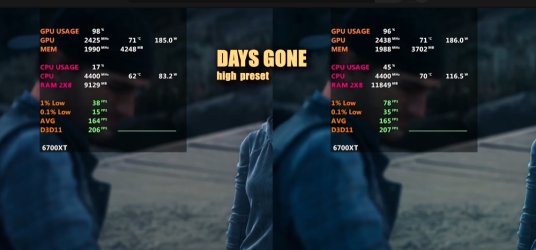- Joined
- Jun 3, 2012
- Messages
- 2,091 (0.43/day)
- Location
- Denmark
| Processor | I5 13600kf |
|---|---|
| Motherboard | Gigabyte Z790 D AX |
| Cooling | Thermalright Assassin X120 R SE Black |
| Memory | G.Skill Ripjaws S5 DDR5-6400 - 32GB - CL32 (6600mhz) |
| Video Card(s) | Asus GeForce® RTX 5060 Ti 16GB Prime |
| Storage | 1x2tb KC3000 & 2tb samsung 970 evo plus, 2 x 2 tb external usb harddrives |
| Display(s) | LG 32GP850, IIyama G2470HSU-B1 |
| Case | Deepcool CG580 |
| Audio Device(s) | Yamaha R-N800A System audio signature 5 + Audio pro addon sub 1 |
| Power Supply | Corsair RM850X White |
| Mouse | Asus Rog Gladius III Wireless Aimpoint |
| Keyboard | Corsair K70 RGB TKL Champion |
| Software | Windows 11 64 bit |
I get mixed results watching ram,memory videos 2 vs 4 ram sticks
Foir a long time i have klnown 4 ram,memory stick top be able to give up to 10% more fps (as the highest results, claim)
Generally yes but some games use the cpu alot when having 4 ram stick,why ? Does the memory controller need it ?

Again yes
Here i def say no
ryzen 7 5700X3d +Corsair Vengeance LPX DDR4-3600 - 32GB - CL16 - Dual Channel (2 pcs) - Intel XMP+ a rtx 4070 dual evo playing at 2560x1440
2x16 gb extra ram, 4x16gb ram or 4x8gb ram i think a 5700X3d should handle 3600mhz cl 16 ram just fine
What does intel vs ryzen or ryzen vs intel ram,memory do on a ryzen 5000 when it's 3600mhz cl 16
I haven't been able to type in google what gives my results on using ryzen ram vs intel ram with a ryzen 5000 cpu, what it does performance wice
Foir a long time i have klnown 4 ram,memory stick top be able to give up to 10% more fps (as the highest results, claim)
Generally yes but some games use the cpu alot when having 4 ram stick,why ? Does the memory controller need it ?

Again yes
Here i def say no
ryzen 7 5700X3d +Corsair Vengeance LPX DDR4-3600 - 32GB - CL16 - Dual Channel (2 pcs) - Intel XMP+ a rtx 4070 dual evo playing at 2560x1440
2x16 gb extra ram, 4x16gb ram or 4x8gb ram i think a 5700X3d should handle 3600mhz cl 16 ram just fine
What does intel vs ryzen or ryzen vs intel ram,memory do on a ryzen 5000 when it's 3600mhz cl 16
I haven't been able to type in google what gives my results on using ryzen ram vs intel ram with a ryzen 5000 cpu, what it does performance wice
Last edited:



 Its the placebo effect in reverse. And, sadly, that really happens.
Its the placebo effect in reverse. And, sadly, that really happens.
